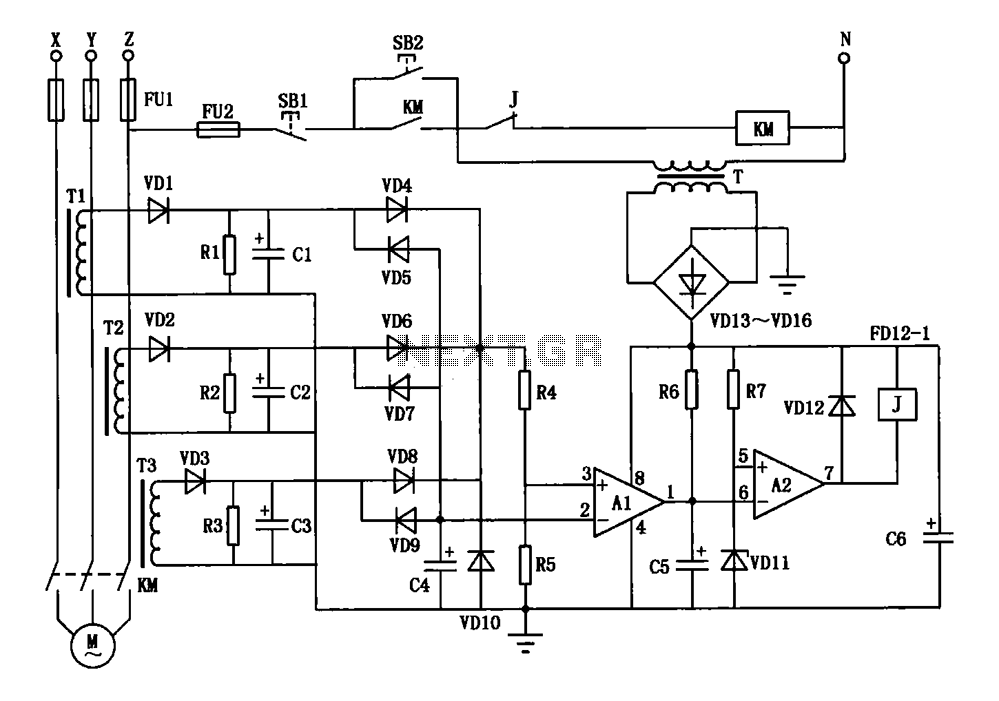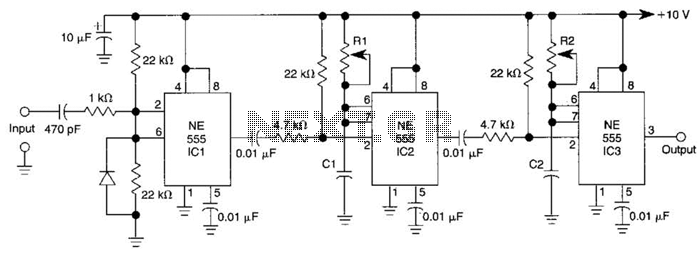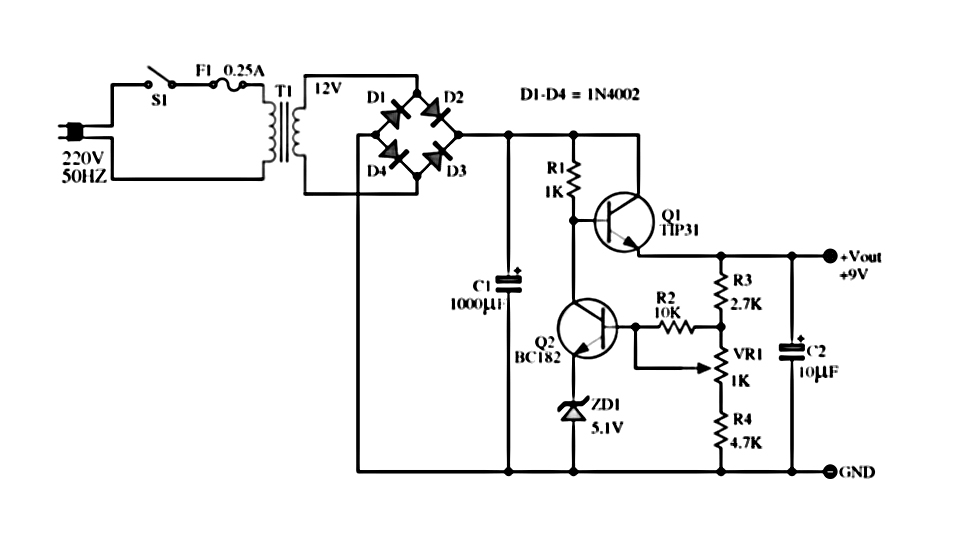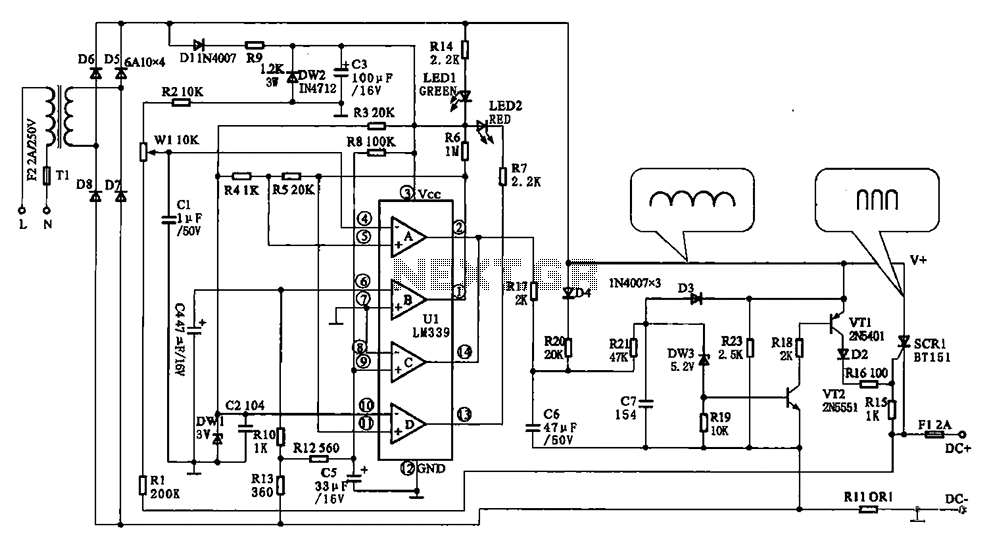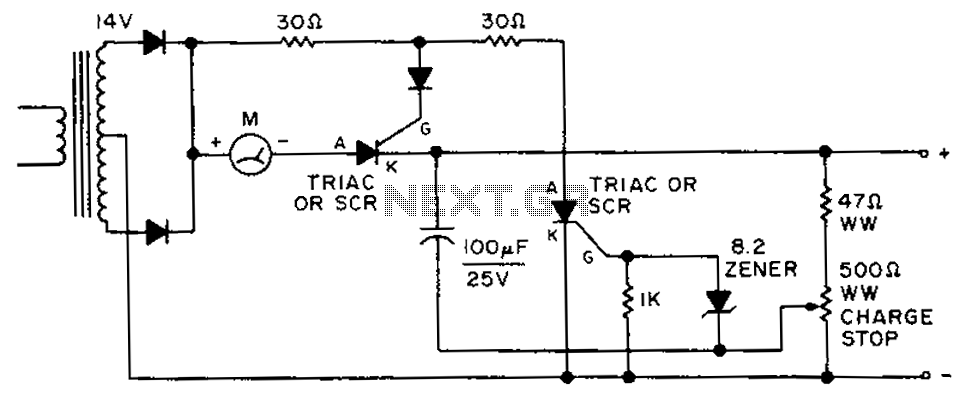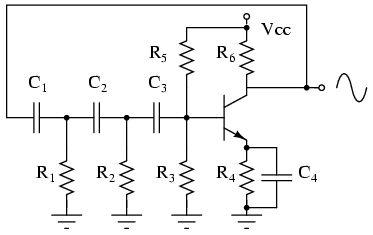
Dark-Activated Alarm With Pulsed Tone Output Circuit
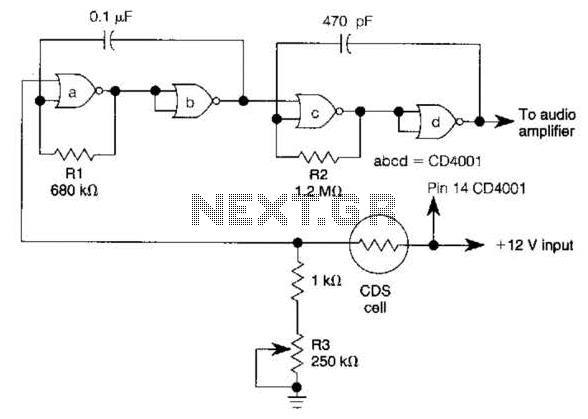
NOR gates A and B create a low-frequency oscillator that activates when the CDS cell, in dark conditions, presents a logic zero to one input of NOR gate A. This low-frequency oscillator, operating at 10 Hz, enables a high-frequency oscillator formed by gates C and D to oscillate at approximately 1000 Hz. Resistor R1 can be adjusted to modify the pulse rate, while R2 can be adjusted to change the tone. Resistor R3 is responsible for setting the trigger point.
The circuit utilizes two NOR gates (A and B) to generate a low-frequency oscillation. Under conditions of low light, the CDS (Cadmium Sulfide) cell reduces its resistance, effectively sending a logic low signal to NOR gate A. This condition activates the low-frequency oscillator, which produces a square wave signal at a frequency of 10 Hz. The output from this oscillator serves as a control signal to enable the high-frequency oscillator formed by NOR gates C and D.
The high-frequency oscillator operates at a frequency of around 1000 Hz, which can be influenced by the configuration and values of the resistors connected to the circuit. Resistor R1 plays a crucial role in determining the pulse rate of the low-frequency oscillator; by varying its resistance, the timing characteristics of the oscillation can be adjusted, allowing for a customizable output frequency.
Resistor R2 is used to modify the tone of the output signal, providing further versatility in the application of the circuit. The tone can be altered based on the resistance value chosen for R2, which affects the waveform characteristics as it passes through the high-frequency oscillator.
Additionally, resistor R3 is integral in establishing the trigger point for the oscillation. It sets the threshold level at which the circuit transitions from one state to another, ensuring reliable operation of the oscillators. The careful selection of these resistors allows for fine-tuning of the circuit's performance, making it suitable for various applications where sound generation or signal modulation is required. Overall, this configuration provides a robust and adjustable solution for generating oscillatory signals in electronic applications. NOR gates a and b form a low-frequency oscillator that is activated when the CDS cell, under dark conditions, causes NOR gate a to see a logic zero at one input. This low-frequency (10 Hz) gates a high-frequency oscillator (c and d) to oscillate at around 1000 Hz.
Rl can be varied to change the pulse rate and R2 to change the tone. R3 sets the trigger point.
The circuit utilizes two NOR gates (A and B) to generate a low-frequency oscillation. Under conditions of low light, the CDS (Cadmium Sulfide) cell reduces its resistance, effectively sending a logic low signal to NOR gate A. This condition activates the low-frequency oscillator, which produces a square wave signal at a frequency of 10 Hz. The output from this oscillator serves as a control signal to enable the high-frequency oscillator formed by NOR gates C and D.
The high-frequency oscillator operates at a frequency of around 1000 Hz, which can be influenced by the configuration and values of the resistors connected to the circuit. Resistor R1 plays a crucial role in determining the pulse rate of the low-frequency oscillator; by varying its resistance, the timing characteristics of the oscillation can be adjusted, allowing for a customizable output frequency.
Resistor R2 is used to modify the tone of the output signal, providing further versatility in the application of the circuit. The tone can be altered based on the resistance value chosen for R2, which affects the waveform characteristics as it passes through the high-frequency oscillator.
Additionally, resistor R3 is integral in establishing the trigger point for the oscillation. It sets the threshold level at which the circuit transitions from one state to another, ensuring reliable operation of the oscillators. The careful selection of these resistors allows for fine-tuning of the circuit's performance, making it suitable for various applications where sound generation or signal modulation is required. Overall, this configuration provides a robust and adjustable solution for generating oscillatory signals in electronic applications. NOR gates a and b form a low-frequency oscillator that is activated when the CDS cell, under dark conditions, causes NOR gate a to see a logic zero at one input. This low-frequency (10 Hz) gates a high-frequency oscillator (c and d) to oscillate at around 1000 Hz.
Rl can be varied to change the pulse rate and R2 to change the tone. R3 sets the trigger point.
